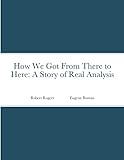How We Got from There to Here A Story of Real Analysis Robert Rogers
Material type: TextSeries: Open textbook libraryDistributor: Minneapolis, MN Open Textbook LibraryPublisher: [Place of publication not identified] Open SUNY [2014]Copyright date: ©2014Description: 1 online resourceContent type:
TextSeries: Open textbook libraryDistributor: Minneapolis, MN Open Textbook LibraryPublisher: [Place of publication not identified] Open SUNY [2014]Copyright date: ©2014Description: 1 online resourceContent type: - text
- computer
- online resource
- 9781312348691
- QA1
1 Numbers, Real (R) and Rational (Q) -- 2 Calculus in the 17th and 18th Centuries -- 3 Questions Concerning Power Series -- 4 Convergence of Sequences and Series -- 5 Convergence of the Taylor Series: A “Tayl” of Three Remainders -- 6 Continuity: What It Isn't and What It Is -- 7 Intermediate and Extreme Values -- 8 Back to Power Series -- 9 Back to the Real Numbers
The typical introductory real analysis text starts with an analysis of the real number system and uses this to develop the definition of a limit, which is then used as a foundation for the definitions encountered thereafter. While this is certainly a reasonable approach from a logical point of view, it is not how the subject evolved, nor is it necessarily the best way to introduce students to the rigorous but highly non-intuitive definitions and proofs found in analysis. This book proposes that an effective way to motivate these definitions is to tell one of the stories (there are many) of the historical development of the subject, from its intuitive beginnings to modern rigor. The definitions and techniques are motivated by the actual difficulties encountered by the intuitive approach and are presented in their historical context. However, this is not a history of analysis book. It is an introductory analysis textbook, presented through the lens of history. As such, it does not simply insert historical snippets to supplement the material. The history is an integral part of the topic, and students are asked to solve problems that occur as they arise in their historical context. This book covers the major topics typically addressed in an introductory undergraduate course in real analysis in their historical order. Written with the student in mind, the book provides guidance for transforming an intuitive understanding into rigorous mathematical arguments. For example, in addition to more traditional problems, major theorems are often stated and a proof is outlined. The student is then asked to fill in the missing details as a homework problem.
Attribution-NonCommercial-ShareAlike
In English.
Description based on print resource
There are no comments on this title.

